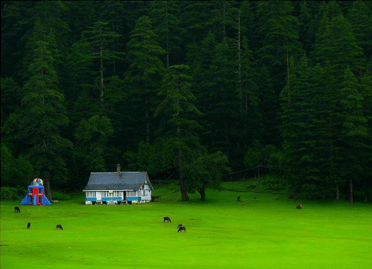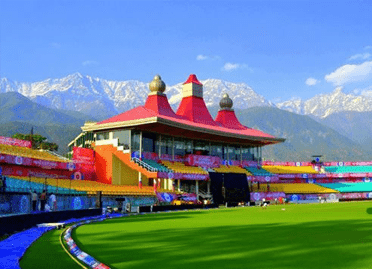Where am I : India Tour Packages » Most Popular Packages » Chamba Tour Packages
View Details

Destinations Covered : Dalhousie » Khajjiar » Chamba » Dainkund Peak
View Details

Destinations Covered : Dharamshala » Dalhousie » Khajjiar » Chamba
Travel to the dreamlands of Chamba
Hello friends, welcome. Today in our post, we will talk about the famous tourist places of Chamba; Chamba is a district of Himachal Pradesh, where today we will talk about the famous tourist places of Chamba. In this article, you will learn about the history of Chamba and the best time to visit Chamba, and how the weather of Chamba remains then. Read this post till the end.
Chamba is a beautiful tourist destination located in the Tehri Garhwal district of Uttarakhand, whose height is about 1524 meters above the sea coast. This place is popular among tourists for its natural surroundings and unpolluted beauty. Surrounded by deodar and pine trees, the unexplored area of ??Chamba is a dreamland for nature lovers. Let's start our travel to the dreamlands of Chamba.
About Chamba
Chamba is a hill district that falls in Himachal Pradesh, India. Chamba is famous for its natural beauty and temples, and many other things. This is situated at an altitude of 996 meters above sea level. Chamba is a tourist place. Along with being it is also known as the city of Himachal. The total area of ??Chamba is 6528 km, here used to be the residence of the kings. Perhaps the king named this city Chamba because of his beloved daughter. Champavati, whose name would also have been named Chamba; here, you will see the signs full of ancient heritage and culture.
The history of Chamba is associated with Raja Maharajas, in which many kings ruled. There used to be many types of princely states here. Varman assumed the first title, and Champa was established in 820 AD. Chamba was named after the princess Champa of the Raja Varman dynasty. Champa, situated on the banks of the Ravi River, is also famous as the city of temples. After 820 AD, kings ruled it somewhere, due to which the kings started changing it in their way.
Monuments in Chamba
Buildings in Chamba were traditionally built using local materials. The buildings were built of dry stone masonry, and the walls and floors of the old houses were plastered with clay and cow dung. Thick wooden beams supported the walls for strength and earthquake resistance. Wooden cantilever structures were often used to support verandahs. Stairs and doors were wooden, and the doors were often decorated with religious bas-reliefs, and on the sides were two lamps for lighting at night. Few of these houses survive today, although some still have adobe roofs in villages on the outskirts.
The old heritage sites, palaces, and temples are located in the old city on the lower slopes of Shah Madar Hill. It is home to the 10th century Champavati Temple, which has marked the birth of the city, the Lakshmi Narayan group of temples, and the 10th century Sita Ram Temple, the Bansi Gopal Temple, Kharura Mohalla, and Hari Rai.
Temple, the 11th century Sui Mata Temple, the Chamunda Devi Temple, and Akhand Chandi Palace overlooking Chaugan have since been converted into a college. The temples built in Chamba show a strong Kashmiri influenced by its stone temple architecture and temple iconography. However, given their age, only their unicellular structure with fluted pillars has been preserved.
Dreamlands of Chamba, Himachal Pradesh
Champavati Temple
Raja Sahil Varman built this temple in memory of his daughter Champavati. It has a wheeled roof and is as big as the Lakshmi Narayan temple. The idol of the goddess Mahishasuramardini is worshiped in the temple. The temple walls are decorated with exquisite stone sculptures connected to its historical and archaeological periodical temple by the Archaeological Survey of India.
Champavati Temple, located in the heart of Chamba city, is a place of pilgrimage for Hindus. It is named after Champavati, daughter of King Sahil Varman, the temple's founder. The temple has great historical and religious significance for many Hindus. The temple of Champavati houses an idol of the goddess Mahisasuramardini, an avatar of the goddess Durga. According to legend, the daughter of King Sahil Varman Champavati was a religious person and regularly visited the temples and ashrams of sadhus.
The king, suspecting her of her actions, followed her to the sadhu's house with a dagger in his cloak. When he reached the ashram, he found that no one was inside. As he was about to return, he heard a voice saying his daughter had been taken away as punishment for his suspicions. He also heard of building a temple in the name of his daughter Champavati if he wanted to avoid further family disasters.
After this, the king constructs the Champavati temple. The Archaeological Survey of India now administers the temple due to its historical and archaeological importance. The main attraction of the temple is its Shikhara-style architecture. Carved stone walls decorated with sculptures make the temple an attractive place for tourists. The temple has a big wheel on the roof, which adores it and makes it the preeminent temple in North India. The Champavati Temple is often compared to the Lakshmi Narayan Temple for its grandeur.
Chaugan
There are too many attractions in Chamba, India. One of which is Chaugan, which is also your final shopping destination. Chamba is famous for many things like the famous Kangra tea, Kangra paintings, and everything organic. Chaugan is the plain in the city where all the significant events in Chamba occur.
Chamundi Devi Temple
Chamundi Devi Temple, located among the snow-covered hills and on the briver banks, is essential for locals and pilgrims. The 300-year-old shrine dedicated to the goddess Kali is the only wooden temple in Chamba with a gabled roof. Its stunning surroundings make it one of the most recommended places to visit in Chamba. View breathtaking views of the Chamba Valley and the Himalayas from the temple. The temple also houses a reservoir in which people are blessed. There is also a craft center within the temple premises from where you can see the famous Kangra paintings, Kangra tea, and wooden artifacts.
Laxmi Narayan temple
Laxmi Narayan Temple is one of the ancient temples of Chamba. It houses the sculptures of Lord Shiva and Lord Vishnu in artistic style, whose carvings are unmatched.
Khajjiar Lake Chamba
This lake named Khajjiar is situated at an altitude of 1920 meters above sea level in the Chamba district of Himachal Pradesh. There are pine and deodar trees around this Khajjiar Lake. Scattering beauty surrounded by dense trees, Khajjiar Lake is a small but beautiful and attractive place in the Chamba district.
This Khajjiar Lake has situated about 24 km from Dalhousie. This is a plateau lake of Himachal Pradesh. This lake has become the most important center of attraction for tourists around here.
Due to the Khajjiar Lake being situated amidst the grasslands of Khajjiar, this place looks quite similar to the plains of Switzerland, which is why it has been given the title of Mini Switzerland due to its beauty.
Lake Hajar
Lake Hadjiar, nestled between an evergreen cedar forest and cotton clouds hanging over it, is the epitome of natural beauty. The lake takes its name from the Khaji Nag Temple located next to the lake. With the weather and a healthful and calm environment, it is hailed as India's "Mini Switzerland." If you're lucky enough to get clear skies, you might even see the reflection of Mount Kailash in the lake. In Chamba, you can enjoy many exciting recreational activities such as paragliding and horseback riding.
Manimahesh Lake
Manimahesh Lake is a gorgeous and attractive mountain lake located in the Bharmour region of Chamba district of Himachal Pradesh state of India at an altitude of about 4080 meters above sea level. This Manimahesh Lake holds the same importance as Mansarovar Lake in the Hindu faith.
Tourists and pilgrims have to walk a distance of 13 kilometers in the mountains to get near this lake. For Hindus, Lake is a pilgrimage site. The journey here is made through the Lambi Narayan temple of Chamba to this lake.
Bhuri Singh Museum
The museum dedicated to the ruler of Chamba, Raja Bhuri Singh, contains all the exhibits related to his reign. The museum was initially established as a showcase for paintings created by Raja Bhuri Singh. But now, it also houses artifacts such as carved doors, murals, coins, and many other historical items that depict Chamba culture and traditions. If you are interested to know about Chaugan's heritage you can know all about it through royal costumes, vintage jewelry and musical instruments of the Chamba royal family.
Akhand Chandi Palace
Built by Raja Umaid Singh in the 18th century, Akhand Chandi Palace is the epitome of royalty and grandeur in the Chamba district. Situated on top of a hill, this beautiful palace offers panoramic views of the entire city and several tourist places like Chamunda Devi Temple and Rang Mahal. Some sections of the palace were built during Mughal architecture, while some were built by the British, due to which you will get to see eclectic architecture here.
Dwat Mahadev Temple
This temple dedicated to Lord Shiva is not only in Chamba Dwat Mahadev Temple but is one of the famous tourist places in Himachal state. It is said about this temple that the Dwat Mahadev temple was built during Mahabharata. The Pandavas built it. There is also an interesting fact of construction that all the stones to make it were brought from Sikri Dhar mountain every night. When the Pandavas went into exile, they built temples throughout India and the temples they established. She went to Himachal Pradesh Dwat Mahadev Temple, located in Chamba. The Shivling in this temple is made of red-colored stone. If you are a nature lover and faith is abundant in your heart, you can visit Dwat Mahadev Temple of Chamba.
Manimahesh Lake
Manimahesh Lake is a magnificent lake in the Chamba district. The lake is part of an important Hindu pilgrimage held in August and September. Surrounded by snow and lush greenery, this lake looks gorgeous.
Church of Scotland
This church, also known as "St. the Raja of Chamba laid the foundation stone for the construction of the new church in the presence of the Scottish Rev. Dr. McClymont, who had come from Scotland. The Raja provided a generous grant for the church's building and ensured it was built with fine masonry. The walls are supported by buttresses, while arched windows provide light and ventilation. The mission governs the territories located on the territory of the church.
Festivals, fairs, and dances
Chamba is one of those places where the Basoli effect was achieved. Two events of "Sukhi Mata Mela" and "Minjar Mela are especially notable in Chamba. A notable event of such fairs is the "chela." subordinate to the deity, enters a trance and answers the questions and prayers of the devotees.
With these festivals, the legends are associated, and the Sui Mata temple's built-in memory of the queen concerns a sacrifice she made to fulfill a prophecy in a dream that said that the water from the Sarota stream could only be accessed through an aqueduct. Suppose the queen or her son was sacrificed. Instead of killing her son, she sacrificed her life for the city. Women and children play a leading role in the festival to commemorate this event. The image of Champavati with the banners of the solar emblem of the Rajputs is carried in procession, dancing, and singing, through Chaugan to the temple of Suhi Mata.
Another famous festival held in Chamba is Minjar. It commemorates the victory of the Raja of Chamba over the ruler of Tragarth and also celebrates the rice and corn crops grown at this time of the year. The festival begins with an offering of "minjar," consisting of a bunch of rice plants and golden silk wrapped in red cloth. Offers also include rupee, seasonal fruit, and coconut.
The event is also commemorated with a flag-raising ceremony at Chaugan, which kicks off culture and social programs. Folk dances and musical performances are known as "Kunjari Malhar" and are part of the celebration. On the festival's last day, a parade is held from Akhand Chandi Palace to the Ravi River, where offerings are made. This marks the event during which Raja Sahil Verman changed the river's course to make the Hari Rai Temple accessible to all devotees.
There are many local dance customs in and around Chamba, reflecting the differences in geographic location. Solo dance or dance of two people, usually performed during the Nuwala ceremony and other significant events such as marriage, etc., and Dangri and Shikri are considered noteworthy.
Notable male dances include:
The Gaddi and Gujar dances,
- Dandaras,
- Nat,
- Gorda,
- Nachan,
- Dharumsde,
- Khad-dumbi,
- Chhinjati.
Notable women's dances include:
- Gurei,
- Dangi,
- Kikli
While dances such as Shine, Dhamal, Sohal, Sal Kukdi Nachan, Ratege, and Til-Chauti are performed by both genders. Several forms of masked dance are also performed in Chamba, such as the Chhatradi Jatar.
Weather of Chamba
Chamba, a district of Himachal Pradesh, India, is covered with mountains from all sides, due to which the weather here remains relatively standard. The season remains the hottest month of the year, from May to July. The temperature here remains around 27 degrees to 35 degrees Celsius. Till the weather remains cold, in the midst of this, you get to see snow here; sometimes the temperature here even goes down to minus degrees, due to which the people here have to face a lot of problems, talk of monsoon. So the monsoon enters between July and September. Meanwhile, there is a lot of rain here.
Best time to visit Chamba
Friends, so far we have come to know about Chamba and have also learned about the tourist place there, now we will also see that if we go to visit Chamba then which will be the best time to visit there, The best time to travel is considered to be when all the people have holidays, i.e., if you want to come with your friends or with family then it is not necessary to have holidays whether it is from school or job and business.
The best time to visit Chamba between September and February if we talk about the best time despite planning a holiday. This is when you will get cold weather here if you want to see snow. You can visit in December-January, and if you want to enjoy the tourist places openly in good weather, you can come here any time after September.
Bottom line
Chamba is a cute provincial town that, in its power of remoteness, did not succumb to the conquests of the Mughals and developed in isolation. The town is famous for its beautiful embroidery, dominated by local women - these embroidered neck scarves and handkerchiefs are used for wrapping gifts or temple offerings. Local temples are considered one of the best in the region. So, if you want to see all these fantastic places, then pack your bags and start your travel to the dreamlands of Chamba right now!
Speak to our Experts!
Instant Quote, Best Deals - 100% Customizable, Includes hotels + car + guides Cost depends on various factors like, number of people you are, travel dates, category of hotel and transportation etc.Drop your Inquiry to get the best deals as per your requirements. 100% Satisfaction Guaranteed. Rated 5* in TripAdvisor.



